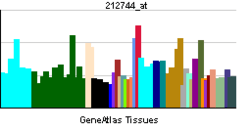BBS4
Bardet-Biedl syndrome 4 is a protein that in humans is encoded by the BBS4 gene.[1][2][3]
This gene encodes a protein which contains tetratricopeptide repeats (TPR), similar to O-linked N-acetylglucosamine transferase. Mutations in this gene have been observed in patients with Bardet-Biedl syndrome type 4. The encoded protein may play a role in pigmentary retinopathy, obesity, polydactyly, renal malformation and mental retardation.[3]
Interactions
BBS4 has been shown to interact with DCTN1.[4]
References
- ↑ Carmi R, Rokhlina T, Kwitek-Black AE, Elbedour K, Nishimura D, Stone EM et al. (Jan 1995). "Use of a DNA pooling strategy to identify a human obesity syndrome locus on chromosome 15". Human Molecular Genetics 4 (1): 9–13. doi:10.1093/hmg/4.1.9. PMID 7711739.
- ↑ Mykytyn K, Braun T, Carmi R, Haider NB, Searby CC, Shastri M et al. (Jun 2001). "Identification of the gene that, when mutated, causes the human obesity syndrome BBS4". Nature Genetics 28 (2): 188–91. doi:10.1038/88925. PMID 11381270.
- ↑ 3.0 3.1 "Entrez Gene: BBS4 Bardet-Biedl syndrome 4".
- ↑ Kim JC, Badano JL, Sibold S, Esmail MA, Hill J, Hoskins BE et al. (May 2004). "The Bardet-Biedl protein BBS4 targets cargo to the pericentriolar region and is required for microtubule anchoring and cell cycle progression". Nature Genetics 36 (5): 462–70. doi:10.1038/ng1352. PMID 15107855.
Further reading
- Haftek J, Krawczykowa Z, Stankiewicz A, Araszkiewicz H, Goś R, Kasprzak H (Jun 1975). "[Ocular manifestations in orbital fractures]". Klinika Oczna 45 (6): 655–9. PMID 1138127. Vancouver style error (help)
- Bruford EA, Riise R, Teague PW, Porter K, Thomson KL, Moore AT et al. (Apr 1997). "Linkage mapping in 29 Bardet-Biedl syndrome families confirms loci in chromosomal regions 11q13, 15q22.3-q23, and 16q21". Genomics 41 (1): 93–9. doi:10.1006/geno.1997.4613. PMID 9126487.
- Katsanis N, Eichers ER, Ansley SJ, Lewis RA, Kayserili H, Hoskins BE et al. (Jul 2002). "BBS4 is a minor contributor to Bardet-Biedl syndrome and may also participate in triallelic inheritance". American Journal of Human Genetics 71 (1): 22–9. doi:10.1086/341031. PMC 384990. PMID 12016587.
- Riise R, Tornqvist K, Wright AF, Mykytyn K, Sheffield VC (Oct 2002). "The phenotype in Norwegian patients with Bardet-Biedl syndrome with mutations in the BBS4 gene". Archives of Ophthalmology 120 (10): 1364–7. doi:10.1001/archopht.120.10.1364. PMID 12365916.
- Hoskins BE, Thorn A, Scambler PJ, Beales PL (Aug 2003). "Evaluation of multiplex capillary heteroduplex analysis: a rapid and sensitive mutation screening technique". Human Mutation 22 (2): 151–7. doi:10.1002/humu.10241. PMID 12872256. Check date values in:
|year= / |date= mismatch(help) - Kim JC, Badano JL, Sibold S, Esmail MA, Hill J, Hoskins BE et al. (May 2004). "The Bardet-Biedl protein BBS4 targets cargo to the pericentriolar region and is required for microtubule anchoring and cell cycle progression". Nature Genetics 36 (5): 462–70. doi:10.1038/ng1352. PMID 15107855.
- Ye X, Dai J, Fang W, Jin W, Guo Y, Song J et al. (Jun 2004). "Cloning and characterization of a splice variant of human Bardet-Biedl syndrome 4 gene (BBS4)". DNA Sequence : The Journal of DNA Sequencing and Mapping 15 (3): 213–8. doi:10.1080/10425170410001679165. PMID 15497446. Check date values in:
|year= / |date= mismatch(help) - Rual JF, Venkatesan K, Hao T, Hirozane-Kishikawa T, Dricot A, Li N et al. (Oct 2005). "Towards a proteome-scale map of the human protein-protein interaction network". Nature 437 (7062): 1173–8. doi:10.1038/nature04209. PMID 16189514.
External links
| ||||||||||||||||||||||||||||||||||||||||

